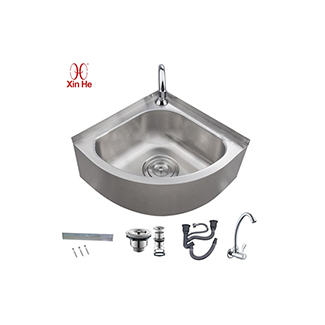The Corner Sink: A Smart Solution for Saving Space
If you manage a business space where every square foot matters—be it a bustling commercial kitchen, a compact laboratory, a busy hotel, or even a utility room—you already understand the challenges of tight layouts. Cluttered work areas, inefficient workflow, and overlooked corners can slow down operations, increase costs, and reduce staff productivity. This is where a corner sink becomes a game-changer. By turning an often-unused corner into a functional work station, a corner sink maximizes efficiency while maintaining hygiene and durability.
At Xinhe, we specialize in stainless steel sinks for B2B applications, including restaurants, hotels, laboratories, commercial facilities, and utility spaces. This article explores the benefits, technical features, installation considerations, and practical applications of corner sinks.
Why Corner Sink Is Ideal for Business Spaces
A corner kitchen sink fits neatly into a 90-degree junction, making the most of areas that would otherwise be wasted. Unlike traditional straight sinks that occupy valuable wall or counter space, a corner sink opens up work areas and enhances ergonomics. Staff can access the sink without obstructing other tasks, reducing spills and improving workflow efficiency.
Key benefits include:
- Maximized Workspace: Corner sinks free up 20-30% more countertop space than conventional sinks, ideal for kitchens with sink in the corner, utility rooms, or compact bath corner sinks.
- Ergonomic Design: Placement in the corner allows for natural hand movement, reducing strain and mess.
- Durability and Strength: Made from 16-gauge 304 or 316 stainless steel, corner sinks resist rust, scratches, and heat, which is crucial for high-traffic environments.
- Hygienic Surfaces: Stainless steel sinks are non-porous, reducing bacterial growth and supporting compliance with NSF standards.
- Customizable Options: Choose from drop-in sinks, undermount sinks, corner lavatory sinks, corner pedestal sinks, 3-compartment sinks, or sinks with drainboards, depending on the space and intended use.
A corner sink kitchen setup allows staff to perform multiple tasks—rinsing, washing, and prepping—without interfering with one another. This design not only increases efficiency but also delivers tangible long-term savings on labor and maintenance costs.

Why Stainless Steel Matters
When investing in a corner sink, material choice is crucial. Stainless steel is the preferred option for commercial and industrial settings due to its combination of durability, hygiene, and aesthetic versatility.
Key advantages of stainless steel sinks include:
- Corrosion Resistance: Stainless steel withstands water, detergents, and chemicals, which is essential in laboratory sinks, industrial sinks, and commercial kitchen sinks.
- Scratch and Heat Resistance: Handles heavy pans, hot liquids, and rigorous cleaning routines without visible wear.
- Easy Maintenance: Smooth surfaces simplify cleaning, and the non-porous finish reduces bacteria and mold accumulation.
- Hygienic Compliance: Many stainless steel sinks meet NSF standards for foodservice or healthcare facilities.
- Long-Term ROI: Durable stainless sinks require fewer replacements than materials like ceramic or plastic, reducing operational costs over time.
For utility rooms, laundries, and workshops, stainless steel corner sinks can handle large volumes of water and heavy-duty cleaning tasks while remaining corrosion-resistant and easy to maintain. Options like stainless utility sinks, laundry sinks, and freestanding utility sinks add flexibility to commercial spaces.
Types of Corner Sinks and Their Features
Xinhe offers a wide range of corner sinks designed for various commercial and utility applications. Below is a detailed overview:
| Type | Description | Key Features | Ideal Use |
|---|---|---|---|
| Corner Pedestal Sink | Free-standing | ADA compliant, ergonomic height | Bathrooms, hospitality areas |
| Corner Lavatory Sink Vanity | Integrated with cabinet | Extra storage, tidy design | Bathrooms, hotels, small spaces |
| 3-Compartment Corner Sink | Multi-basin | Separates washing, rinsing, and sanitizing | Commercial kitchens, labs, industrial cleaning |
| Utility Corner Sink | Deep basin | Handles heavy-duty cleaning, laundry | Garages, basements, utility rooms |
| Corner Sink with Drainboard | Prep and drying station | Protects counters, adds workspace | Kitchens, labs, bars, workshops |
| Small Corner Sink | Compact design | Fits tight spaces, easy installation | Powder rooms, small bathrooms, service stations |
| Corner Bathroom Vanity with Sink | Vanity-integrated | Storage plus sink functionality | Hotel bathrooms, public restrooms |
| Drop-In Corner Sink | Easy installation | Suitable for retrofits, flexible placement | Commercial kitchens, labs |
| Undermount Corner Sink | Sleek look | Seamless countertop integration | High-end kitchens, lab prep stations |
Each model undergoes strict quality control, including leak tests, weld inspections, surface checks, and depth measurements. Deep basins (up to 10 inches) ensure that large pots, lab equipment, or laundry loads can be handled efficiently.
Corner Sinks in Action
1. Commercial Kitchens & Restaurants
- Corner sinks act as prep sinks or secondary washing stations, freeing up space for cooking and plating.
- Double kitchen sinks allow simultaneous washing and rinsing, improving workflow during peak hours.
- Kitchen sink racks and drainboard sinks complement the setup, creating a mini workstation.
- Helps maintain hygiene by isolating cleaning zones, reducing cross-contamination in high-volume kitchens.
- Ideal for restaurant sinks, commercial stainless sinks, and prep sinks.
2. Bathrooms & Hospitality Spaces
- Corner bathroom sinks and corner sink vanities optimize small hotel or public bathroom layouts.
- Laundry sinks and deep utility sinks manage towels, linens, or housekeeping tasks efficiently.
- Corner placement maximizes walking space while maintaining accessibility.
3. Laboratories & Healthcare Facilities
- Industrial corner sinks resist chemical damage and support sterile workflows.
- ADA compliant sinks provide accessibility for staff and patients.
- Handwash sinks near prep zones ensure hygiene compliance in labs and hospitals.
4. Utility Rooms & Workshops
- Garage utility sinks, basement sinks, or laundry utility sinks manage tough cleaning jobs.
- Compact small utility sinks fit in corners without wasting space.
- Freestanding utility sinks allow flexible placement in large or mobile workspaces.
- Black utility sinks or stainless models offer durability for heavy-duty cleaning.
5. Other Commercial Spaces
- Airports, retail stores, warehouses: commercial bathroom sinks or service sinks improve workflow.
- Slop sinks and mop sinks handle messes efficiently.
- Corner sinks in public areas contribute to hygiene compliance and reduce maintenance overhead.

Tips for Selecting the Right Corner Sink
Selecting a corner sink requires attention to space, materials, configuration, installation, and long-term value. Here’s a structured approach:
- Assess Your Space
- Measure the corner and verify compatibility with corner sink base cabinets.
- Consider 30 inch sinks, 36 inch sinks, or small corner sinks for tight areas.
- Ensure there’s sufficient clearance for faucets, sink baskets, and accessories.
- Choose the Right Material
- Stainless steel is ideal for utility sinks, laundry sinks, commercial kitchen sinks, and industrial sinks.
- 16-gauge steel balances strength with manageability.
- NSF-certified sinks ensure hygiene compliance.
- Select Appropriate Configuration
- Single bowl, double sink, 3-compartment sink, or three bay sink depending on tasks.
- Include functional add-ons like commercial sink faucets, sink with drainboard, or sink racks.
- Consider Installation & Compliance
- Drop-in vs. underslung kitchen sinks depending on countertop style.
- Verify ADA compliance for public spaces or hospitals (ADA sink height, ADA compliant sink).
- Plan for Long-Term Value
- Stainless laundry sinks or stainless utility sinks may have higher upfront costs but last longer.
- Durable sinks reduce downtime, repair costs, and replacement frequency.
- Check Adaptability
- Ensure compatibility with corner sink cabinets, freestanding utility sinks, or corner lavatory sink vanities.
- Custom solutions may include drainboard sinks, wall mount sinks, or portable sink stations for specific workflows.
Installation and Maintenance Best Practices
- Secure the Base: Ensure the corner sink base cabinet is level and reinforced to support the sink and its contents.
- Plumbing Connections: Verify that floor sink drains, mop sink faucets, and commercial sink faucets are correctly installed for optimal flow.
- Seal and Protect: For underslung kitchen sinks or drop-in sinks, apply high-quality silicone sealant to prevent leaks.
- Routine Cleaning: Use non-abrasive cleaners suitable for stainless steel sinks, stainless utility sinks, and laundry tubs.
- Accessory Optimization: Add kitchen sink racks, drainboards, and sink basket strainers to maintain workspace organization.
Common Questions About Corner Sinks
Q1: Can a corner sink fit in small bathrooms?
Yes, small corner sinks and corner bathroom vanity sinks are specifically designed to fit tight spaces without sacrificing functionality.
Q2: What type of stainless steel is best?
304 and 316 stainless steel are preferred. 304 is standard for commercial applications, while 316 offers higher corrosion resistance for harsh environments.
Q3: Are corner sinks ADA compliant?
Many models, including corner pedestal sinks and corner lavatory sinks, meet ADA height and accessibility requirements.
Q4: Can I use a corner sink in a commercial kitchen?
Absolutely. Options like double kitchen sinks, 3-compartment sinks, and corner sink with drainboard are ideal for high-volume kitchens.
Q5: How do I maintain a stainless steel corner sink?
Regular cleaning with mild detergents, drying after use, and avoiding abrasive tools will keep your sink in top condition.
Conclusion
A corner sink is more than a space-saving solution; it’s a strategic investment for commercial, hospitality, laboratory, and industrial spaces. From corner kitchen sinks to corner bathroom vanities, utility sinks, and laundry sinks, these versatile installations improve efficiency, hygiene, and long-term ROI. Xinhe’s stainless steel corner sinks deliver durability, customization, and professional-grade performance tailored to your B2B needs.
For more information, product options, and B2B customizations, visit Xinhe Stainless.






